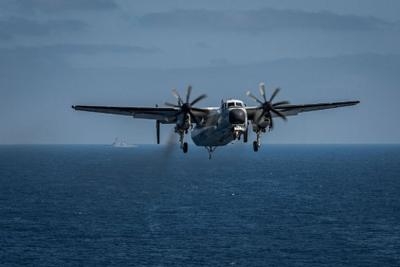Thu, Feb 22, 2018
Aircraft Went Down In The Philippine Sea In November
A Navy-led mission aboard research vessel RV Petrel has mapped the wreckage of a C-2A Greyhound aircraft that crashed into the Philippine Sea en route to USS Ronald Reagan, Nov. 22, 2017.

Using the vessel's side scan sonar and remote operated vehicle (ROV) to survey the aircraft from Feb. 2-5, the team determined the aircraft lies on the ocean floor in two main sections, cockpit and fuselage, and that the C-2A's flight recorder or black box is still intact.
Planning continues for an upcoming salvage mission, during which every effort will be made to bring both sections to the surface despite very challenging environmental conditions. At a depth of 18,500 feet (more than three nautical miles) this will be the deepest aircraft recovery to date and the team with have to contend with several variables including deep water rigging and weather that may affect retrieval.
The aircraft was initially discovered late last year (Dec. 29) by a U.S. Navy Supervisor of Salvage and Diving (SUPSALV) team using a towed pinger locator (TPL-25) system aboard a different contracted vessel. In January, the Navy contracted RV Petrel to support debris field mapping and inform aircraft recovery planning.
RV Petrel is a 250-foot research and exploration vessel with advanced underwater equipment and technology, making it capable of exploring to more than 3.5 miles. A team of SUPSALV personnel embarked Petrel late January and returned to the crash site.
Assigned to Fleet Logistics Support Squadron (VRC 30) forward deployed to Japan, the C-2A aircraft was carrying 11 crew and passengers when it crashed. Eight personnel were recovered immediately by U.S. Navy Helicopter Sea Combat Squadron (HSC 12). For the next three days, Ronald Reagan led combined search and rescue for three Sailors with the Japan Maritime Self Defense Force (JMSDF), covering nearly 1,000 square nautical miles before ending the search.
(Image provided with U.S. Navy news release)
More News
Airport Marking Aids Markings used on runway and taxiway surfaces to identify a specific runway, a runway threshold, a centerline, a hold line, etc. A runway should be marked in ac>[...]
"It is extremely difficult, if not impossible, for manned aircraft to see a drone while conducting crop-enhancing and other aerial applications at low altitudes and high speeds. We>[...]
Aero Linx: The Skyhawk Association The Skyhawk Association is a non-profit organization founded by former Skyhawk Pilots which is open to anyone with an affinity for the A-4 Skyhaw>[...]
“The T-54A benefits from an active Beechcraft King Air assembly line in Wichita, Kansas, where all required METS avionics and interior modifications are installed on the line>[...]
Aero Linx: Aerostar Owners Association The Association offers the Aerostar Owner a unique opportunity to tap an invaluable source of information concerning the care and feeding of >[...]
 ANN's Daily Aero-Term (04.28.24): Airport Marking Aids
ANN's Daily Aero-Term (04.28.24): Airport Marking Aids Aero-News: Quote of the Day (04.28.24)
Aero-News: Quote of the Day (04.28.24) ANN's Daily Aero-Linx (04.28.24)
ANN's Daily Aero-Linx (04.28.24) Aero-News: Quote of the Day (04.29.24)
Aero-News: Quote of the Day (04.29.24) ANN's Daily Aero-Linx (04.29.24)
ANN's Daily Aero-Linx (04.29.24)



